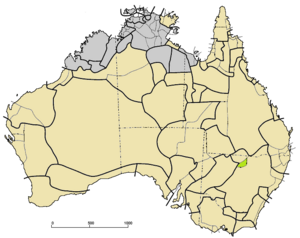Barranbinja language facts for kids
Quick facts for kids Barranbinja |
|
|---|---|
| Native to | Australia |
| Region | New South Wales |
| Ethnicity | Barranbinya |
| Extinct | 1979 |
| Language family |
Pama–Nyungan
|
| AIATSIS | D26 |

Barranbinja (green) among other Pama–Nyungan languages (tan)
|
|
Barranbinja, also called Barrabinya, was an Aboriginal language from New South Wales, Australia. Sadly, it is now an extinct language. This means no one speaks it as their main language anymore.
The last person who likely spoke Barranbinja was Mrs. Emily Margaret Horneville. She passed away in 1979. A researcher named Lynette Oates recorded Mrs. Horneville speaking the language. Later, Oates wrote a short description of Barranbinja. Another researcher, R.H. Mathews, had also recorded some words from Barranbinja and Muruwari. Both Mathews and Oates thought that Barranbinja and Muruwari were like two different ways of speaking the same language, similar to dialects.
How Barranbinja is Connected to Other Languages
Lynette Oates studied both the Muruwari and Barranbinja languages. She found that about 44% of their words were similar. This made her believe they were closely related, perhaps even different dialects of one language. R.H. Mathews, who recorded both languages earlier, also noticed this. He said that even though some words were different, the way sentences were put together (the grammar) was almost the same.
Barranbinja and Muruwari together form a special group within the larger Pama-Nyungan language family. This family includes many Aboriginal languages in Australia. Barranbinja and Muruwari were quite different from other languages spoken nearby. Those neighboring languages belonged to different Pama-Nyungan groups.
Sounds of the Language
The sounds used in Barranbinja were very similar to those in Muruwari. However, because there isn't a lot of recorded Barranbinja speech, it's hard to be completely sure about every single sound.
Most Barranbinja words ended with a vowel sound (like 'a', 'e', 'i', 'o', 'u'). It was rare for words to end with a consonant sound. This is different from some nearby languages like Muruwari and Ngiyambaa, where words often end with sounds like 'n' or 'm'. Researchers think this might be because Barranbinja was influenced by languages like Paakantyi, which also prefer words ending in vowels.
See also
 In Spanish: Idioma barranbinja para niños
In Spanish: Idioma barranbinja para niños

